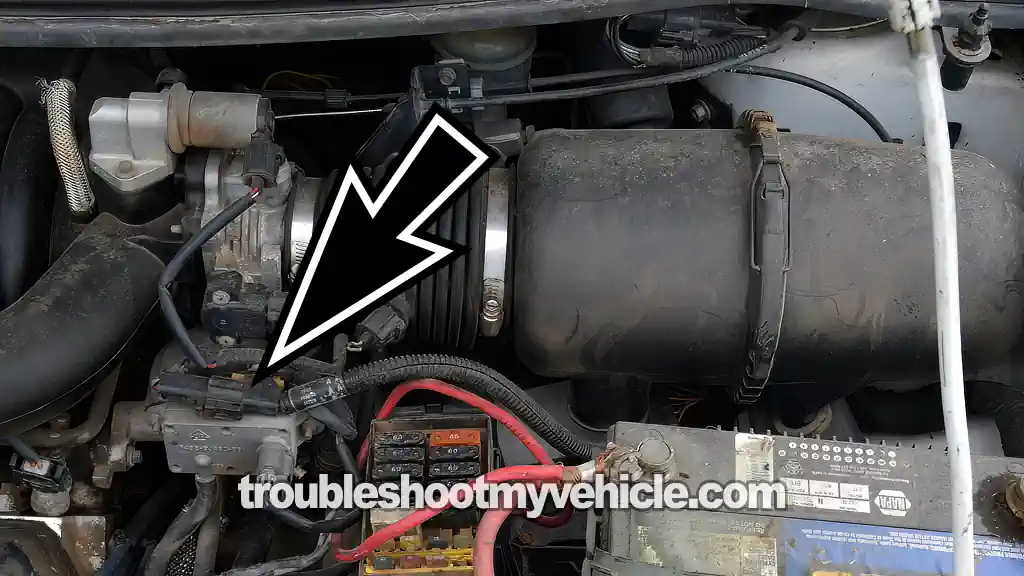
The Mass Airflow (MAF) sensor on the 1996-1998 3.8L V6 Ford Windstar can be easily tested with a simple multimeter. Although it's located inside the round air filter canister assembly, you don't need to remove it to test it.
In this tutorial, I'm going to explain the four tests you need to perform to find out if the MAF sensor is good or bad —and they're all done using just a multimeter. Here's what we'll check:
- The MAF sensor's output voltage signal.
- That it's getting VPWR power.
- That it's getting PWR GND Ground.
- That the PCM is supplying the MAF RTN Ground.
With the results of these four multimeter tests, you'll quickly and easily know whether the MAF sensor is toast and needs to be replaced —or if the issue lies elsewhere.
Contents of this tutorial:
- Symptoms Of A Bad MAF Sensor.
- MAF Sensor Circuit Descriptions.
- Where To Buy The MAF Sensor And Save.
- TEST 1: Testing The MAF Signal.
- TEST 2: Making Sure The MAF Sensor Is Getting Power (VPWR).
- TEST 3: Making Sure The MAF Sensor Is Getting Ground (PWR GND).
- TEST 4: Making Sure The MAF Sensor Is Getting Ground (MAF RTN).
- More 3.8L V6 Ford Windstar Diagnostic Tutorials.
APPLIES TO: This tutorial applies to the following vehicles:
- 3.8L V6 Ford Windstar: 1996, 1997, 1998.
1995 MAF SENSOR TESTS:
Symptoms Of A Bad MAF Sensor
The sole purpose of the MAF sensor on your Ford Windstar is to measure the amount of air the engine is breathing as it runs. It then sends this information to the PCM, which uses it to calculate the correct amount of fuel to inject.
So when the MAF sensor fails —the engine enters a world of hurt as performance takes a hit. You'll notice one or more of the following symptoms:
- Check engine light: The CEL will be lit on the dash, and the computer will usually store one of these codes:
- P0102: MAF Sensor Signal Low.
- P0103: MAF Sensor Signal High.
- Lack of power: Your Windstar or Sable's engine may feel weak or hesitate when you hit the gas, especially under load or at higher speeds.
- Rough idle/stalling: The engine can idle unevenly or shut off on its own.
- Bad gas mileage: A bad MAF affects the PCM's ability to control the air-fuel mixture, making the engine run rich or lean, which kills gas mileage.
- Black exhaust smoke: If the PCM is adding too much fuel because of a bad MAF sensor signal, you may see black smoke coming out of the tailpipe.
- Hard starting: Sometimes the engine will crank but struggle to start.
- Hesitation or surging: You might feel the engine stumble or surge while accelerating or cruising.
MAF Sensor Circuit Descriptions
The MAF sensor on your Windstar is located inside the round air filter canister assembly. Now, to test it, we don't need to remove it from the housing. What we're going to do instead is check all the signals at the round, 4-wire connector that comes out of that air cleaner assembly (see image 2 of 2 above).
In the table below, you'll find a brief description of the four wires on that connector:
| Pin | Wire | Description |
|---|---|---|
| 2 | Red (RED) | VPWR –12 Volts Input in RUN or START |
| 3 | Black with white stripe (BLK/WHT) | PWR GND –Chassis Ground Input |
| 4 | Tan with light blue stripe (TAN/LT BLU) | MAF RTN –MAF sensor Ground (provided by PCM) |
| 5 | Light blue with red stripe (LT BLU/RED) | MAF –MAF signal |
IMPORTANT: The engine wiring harness (PCM side) MAF sensor connector has male round terminals, while the connector going to the air canister assembly has female terminals.
What Tools Do I Need To Test The MAF Sensor?
The cool thing about testing the MAF sensor is that you don't need any expensive diagnostic equipment —not even a scan tool. Here's what you'll need:
- A multimeter: To check the MAF signal voltage output, and verify power and Ground to the sensor.
- A wire-piercing probe or back probe: This tool lets you access the MAF signal voltage inside the MAF signal wire in TEST 1.
If you need to buy a multimeter, want to upgrade the one you've got, or don't have a wire-piercing probe kit, I've got a few recommendations for you below. These tools aren't expensive, they're very reliable, and they're the same ones I personally use in my diagnostic work:
Disclosure: As an Amazon Associate, I earn from qualifying purchases. If my tutorials help you, using these links is an easy way to support the site at no extra cost to you. Thank you!
Where To Buy The MAF Sensor And Save
When you're ready to replace the MAF sensor on your Ford Windstar, it's always best to stick with known aftermarket brands. The two links below are for MAF sensors from manufacturers I've used throughout my entire automotive repair career —brands I trust and never hesitate to recommend.
Disclosure: As an Amazon Associate, I earn from qualifying purchases. If my tutorials help you, using these links is an easy way to support the site at no extra cost to you. Thank you!
NOTE: Not sure if the indicated MAF sensors fit your particular 1996-1998 3.8L V6 Ford Windstar? Don't worry. Once you get to the site, they'll ask you for the specifics of your particular vehicle. If it doesn't fit, they'll find you the right one.
TEST 1: Testing The MAF Signal
To get started, we're going to check the signal the MAF sensor is producing. To know whether that signal is good or not, we need to understand how it reacts to the amount of air the engine is breathing. Specifically:
- When the engine is idling and RPMs are low, less air is entering the engine —so the MAF sensor produces a low voltage signal (0.6 - 0.8 Volts).
- When the engine is revved up, more air enters the engine, and the MAF sensor reacts by increasing its signal voltage (1.4 - 2.0 Volts) to match the higher airflow.
We can easily check this by tapping into the MAF signal wire with our multimeter and watching the reading as we rev the engine up and down.
The MAF voltage signal should rise as RPM increases and drop as RPM decreases. If the MAF sensor is toast, the voltage will usually stay stuck at one value no matter how much you rev the engine.
IMPORTANT: The MAF sensor must remain plugged into its connector while doing this check. You'll need to back probe the connector or pierce the wire with a probe. This is the same tool I use and recommend: Goupchn 4mm Banana to Banana Plug Test Leads Kit (Amazon affiliate link).
NOTE: All of the tests in this tutorial are done with the MAF sensor in place inside the round air filter canister assembly. Also, all air ducts and the canister assembly need to be connected and properly seated.
Here's what we need to do:
- 1
Set your multimeter to Volts DC.
- 2
Connect the black lead of the multimeter to the battery negative (-) terminal.
- 3
Connect the red lead to the light blue with red stripe (LT BLU/RED) wire using a proper back probe or wire-piercing tool.
This LT BLU/RED wire is the one that delivers the MAF signal to the PCM.
NOTE: You'll be making your test connection on the wire that belongs to the round wiring harness connector located outside the air filter canister assembly. See photo 2 of 2 in the image viewer above to identify this connector. - 4
Start the engine and let it idle.
Once idle smooths out, note the voltage reading on the multimeter. A little fluctuation is normal. This first reading is your base MAF signal voltage. - 5
Rev the engine by opening the throttle.
You can do this at the throttle body by moving the linkage, or by having a helper step on the accelerator pedal. - 6
The MAF signal voltage should rise as RPM increases.
- 7
Release the throttle to let the RPM come back down.
- 8
The voltage should drop as the RPMs fall.
- 9
Repeat the accelerate/release cycle a few times to verify the results are consistent.
Here's how to interpret your results:
CASE 1: The signal voltage went up as engine speed increased and dropped when you let off the throttle. This tells us the MAF sensor is functioning correctly since it's reacting to changes in air intake as you rev the engine.
If you've got a P0102 (MAF Signal Low) or P0103 (MAF Signal High) code lighting up the check engine light on your Ford Windstar, whatever caused that code isn't happening right now —because the signal is responding to airflow changes instead of staying stuck high or low.
CASE 2: The signal voltage stayed the same no matter how the engine speed changed. If the sensor's signal output voltage stays stuck at one value as you rev the engine, then more than likely, you've got a bad sensor on your hands.
To be sure the MAF sensor is actually toast, we need to confirm that it's getting VPWR power and that it has both the PWR GND Ground and the PCM-supplied MAF RTN Ground. For the first of these tests, head over to: TEST 2: Making Sure The MAF Sensor Is Getting Power (VPWR).
TEST 2: Making Sure The MAF Sensor Is Getting Power (VPWR)

Now that you've confirmed the MAF signal voltage stays stuck at one value as you rev the engine, our next step is to make sure the sensor is actually getting power.
This VPWR power comes in the form of 10 to 12 Volts, delivered to the sensor through the red (RED) wire of the MAF sensor's 4-wire connector.
The connector we'll be working with is the one located outside the air filter canister assembly. If you look at image 2 of 2 in the viewer above, the arrow points to this exact connector.
All of our tests will be done on the connector that belongs to the engine wiring harness (the PCM side), not the one attached to the canister assembly. The PCM-side connector has round male terminals.
One more thing —the RED wire connects to male terminal 2 of the connector. We'll check for the 12V VPWR voltage with the key in the RUN position but with the engine OFF.
Let's get going:
- 1
Disconnect the MAF sensor from its connector.
NOTE: This connector is the one located outside of the air filter canister assembly. - 2
Put your multimeter in Volts DC mode.
- 3
Connect the black multimeter lead to the battery negative (-) terminal.
- 4
Probe male terminal number 2 with the red multimeter lead.
Terminal 2 should connect to the RED wire on the MAF sensor's 4-wire connector.
NOTE: Remember, you're probing the male terminal of the connector that belongs to the engine wiring harness —this is the PCM side of the circuit. - 5
Turn the key to the RUN position, but don't crank or start the engine.
- 6
The multimeter should display 10 to 12 Volts.
Here's how to interpret your results:
CASE 1: The multimeter displayed 10 to 12 Volts. Awesome —this is exactly what we want to see, and it confirms the sensor is getting power.
Now that you've verified the sensor is receiving the voltage it needs to function, our next step is to make sure it has a solid path to chassis Ground (PWR GND). For this test, head over to: TEST 3: Making Sure The MAF Sensor Is Getting Ground (PWR GND).
CASE 2: The multimeter did not display 10 to 12 Volts. Double-check that you're probing the correct terminal on the connector and repeat the test.
If you still don't see 10 to 12 Volts at the terminal, you can rule out the MAF sensor itself as the cause of the engine performance issue or the MAF trouble code.
Your next step is to focus your troubleshooting on finding out why this voltage is missing and restore it to the circuit. Once the sensor is getting VPWR power, it should function normally again, and the MAF diagnostic trouble code (DTC) should clear.
TEST 3: Making Sure The MAF Sensor Is Getting Ground (PWR GND)

Alright, up to this point, you've confirmed that the MAF signal stays stuck at one value as you rev the engine and that it's getting VPWR power.
For our third test, we're going to make sure the black with white stripe (BLK/WHT) wire is delivering PWR GND Ground to the sensor.
This PWR GND Ground is a chassis Ground, and it should be present at male terminal 3 of the engine wiring harness connector.
To check for the presence of this PWR GND Ground at terminal 3, we'll do a simple multimeter voltage test.
NOTE: Since this is a chassis Ground, it's available at all times —meaning it doesn't matter whether the key is in the OFF, RUN, or START position— this Ground should always be present.
These are the test steps:
- 1
Unplug the MAF sensor from its connector.
- 2
Set your multimeter to Volts DC.
- 3
Hook up the red multimeter lead to the battery positive (+) terminal.
- 4
Probe male terminal number 3 with the black multimeter lead.
Terminal 3 should correspond to the BLK/WHT wire at the MAF sensor connector.
NOTE: Remember, you're probing the male terminal of the connector that belongs to the engine wiring harness —this is the PCM side of the circuit. - 5
Your meter should show between 10 and 12 Volts.
NOTE: Because this is a chassis Ground, it will always be present, whether the key is ON or OFF.
Here's how to interpret the results:
CASE 1: The multimeter displayed 10 to 12 Volts. This confirms that the MAF sensor is getting PWR GND Ground.
We can now move on to our final diagnostic test —making sure your Windstar's PCM is providing the MAF RTN Ground to the sensor. Head over to: TEST 4: Making Sure The MAF Sensor Is Getting Ground (MAF RTN).
CASE 2: The multimeter did not display 10 to 12 Volts. Double-check that you're probing the correct terminal and repeat the test.
If you still don't see the indicated voltage on your multimeter, then chassis Ground isn't being delivered to the MAF sensor.
Your next step is to troubleshoot why this PWR GND Ground is missing and restore it. Once the MAF sensor is getting chassis Ground at terminal 3, it'll function normally again, and the MAF code should clear.
TEST 4: Making Sure The MAF Sensor Is Getting Ground (MAF RTN)

So, you've completed three tests, and they've confirmed the following:
- The MAF sensor's output signal voltage is stuck and doesn't respond to engine RPM increases or decreases —TEST 1.
- It's getting VPWR power —TEST 2.
- It's getting PWR GND chassis Ground —TEST 3.
For our final test, we're going to check that the tan with light blue stripe (TAN/LT BLU) wire is delivering the MAF RTN Ground.
This Ground is supplied internally by your Windstar's PCM and is only available when the key is in the RUN or START position. For our purposes, we'll check it with the key in the RUN position but with the engine OFF.
To verify the presence of this MAF RTN Ground, we'll perform a simple multimeter voltage test at terminal 4 of the engine wiring harness connector.
CAUTION: Be careful with this circuit. Do not apply battery 12V directly to this wire or terminal —doing so will fry the PCM. The multimeter voltage test I describe below is a safe way to confirm the presence of this PCM-supplied Ground at terminal 4.
These are the test steps:
- 1
Disconnect the MAF sensor from its electrical connector.
- 2
Place your multimeter in Volts DC mode.
- 3
Connect the red multimeter test lead to the battery positive (+) terminal.
- 4
Probe male terminal number 4 with the black multimeter test lead.
Terminal number 4 should correspond to the TAN/LT BLU wire of the MAF sensor connector. - 5
Turn the key to the RUN position but don't crank or start the engine.
- 6
You should see 10 to 12 Volts on the multimeter.
Let's see what your test results mean:
CASE 1: The multimeter displayed 10 to 12 Volts. This test result confirms that the MAF sensor is getting the MAF RTN Ground from your Windstar's PCM.
You can correctly conclude that the MAF sensor is bad and needs to be replaced only if you've confirmed all of the following:
- The sensor's signal output voltage does not react to increases or decreases in engine RPM (TEST 1).
- The sensor is getting its 12-Volt VPWR power supply (TEST 2).
- It's getting its PWR GND chassis Ground (TEST 3).
- And in this final test, the PCM is supplying the MAF RTN Ground.
When it's time to replace the MAF sensor, the Delphi one below is a solid choice:
- Delphi Mass Air Flow Sensor - AF10120 (Amazon affiliate link).
CASE 2: The multimeter did not display 10 to 12 Volts. Make sure you're testing the correct terminal and repeat the test.
If your multimeter still doesn't show the indicated voltage, then the MAF sensor isn't getting the MAF RTN Ground from your Windstar's PCM. This rules out the MAF sensor itself as being bad or the cause of the MAF trouble code lighting up the check engine light.
Your next step is to troubleshoot why this MAF RTN Ground is missing and restore it to the circuit. The most likely cause of this issue is an open-circuit in the TAN/LT BLU wire between the MAF sensor connector and the PCM.
More 3.8L V6 Ford Windstar Diagnostic Tutorials
You can find a complete list of 3.8L V6 Ford Windstar diagnostic tutorials in this index:
Here's a sample of the diagnostic tutorials you'll find in the index:
- How To Test The TPS (1996-1999 3.8L V6 Ford Windstar).
- How To Test The Fuel Pump (1995-1998 3.8L V6 Ford Windstar).
- How To Test For A Blown Head Gasket (1995-2003 3.8L V6 Ford Windstar).
- How To Do And Interpret An Engine Compression Test (1995-2003 3.8L V6 Ford Windstar).

If this info saved the day, buy me a beer!





